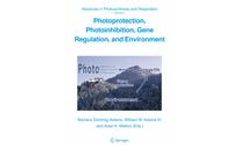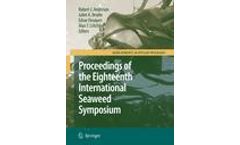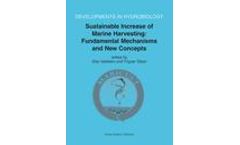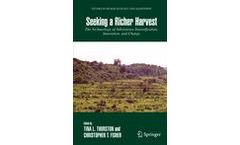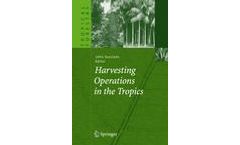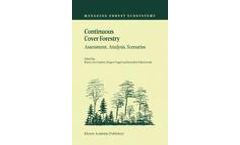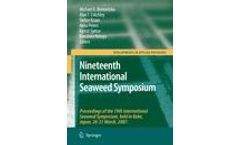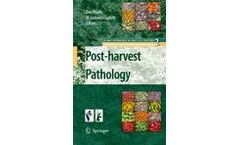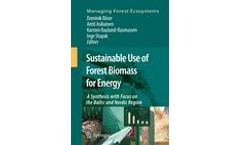Refine by
harvesting-system books
19 books found
“Excess light”, absorbed by the light-harvesting systems of photosynthetic organisms, is an integrative indicator of the environment, communicating the presence of intense light and any ...
“Excess light”, absorbed by the light-harvesting systems of photosynthetic organisms, is an integrative indicator of the environment, communicating the presence of intense light and any ...
Learn what it takes to move your yield from 3 tons to 6 or 9 tons. Emphasizes three key areas of alfalfa management - establishment, production, and harvest - and contains new research and recommendations on: Roundup Ready alfalfa, potato leap hopper and PHL resistance, Aphanomyces race 2, value of short rotations, digestible fiber and RFQ, and minimizing wheel traffic ...
The Proceedings of the 18th International Seaweed Symposium provides an invaluable reference to a wide range of fields in applied phycology. Papers cover topics as diverse as systematics, ecology, commercial applications, carbohydrate chemistry and applications, harvesting biology, cultivation and more. Contributions from all parts of the world give the volume exceptional relevance in an ...
"How can we increase the production and harvest of living marine resources in the new millennium? Bridging potentials and environmental constraints". This was the theme of the 1st Maricult Conference arranged in Trondheim, Norway in June 2000 in connection with termination of the Norwegian research programme Maricult (1996-2000; www.maricult.org). The intention for the conference was not only to ...
This book reviews all aspects of insect pests of tobacco and the subsequent control methods from the harvesting through to the production and storage of finished tobacco products. Control procedures to eliminate outbreaks of infestation are reviewed and a number of case histories are described to demonstrate integration of the methodologies. ...
Subsistence intensification, innovation and change have long figured prominently in explanations for the development of social complexity among foragers and horticulturalists, and the rise of chiefly societies and archaic states, yet there is considerable debate over the actual mechanisms that promote these processes. Traditional approaches to the "intensification question" emphasize population ...
The book brings together information on harvest methods, system productivity, and methods for conducting safe, efficient, and environmentally acceptable operations in tropical forests. It highlights the challenges of harvest operations in the tropics, includes techniques that have been shown to be successful, and discusses newer technologies. ...
Designed especially for growers and extension agents, this four-color guide focuses on three main areas-production, harvest and storage, and feeding silage. The purpose of this publication is to provide the most recent information on cost effective, safe, and environmentally sound ways to produce and use high quality corn ...
The large-scale application of new silvicultural systems has become a political reality in many parts of the world. This involves a gradual tarnsformation of traditional silvicultural practice towards Continuous Cover Forestry (CCF), also know as near-natural forest management, favouring mixed uneven-aged stands, site-adapted tree species and selective ...
With 2.5 million square kilometers of largely intact tropical rainforest and savannah, 10–15% of the world’s fresh water reserves and an extremely rich and highly endemic biodiversity, the Guiana Shield ranks among the most important ecological regions in the world. This report highlights the Non-Timber Forest Products (NTFPs) of the Guiana Shield. The data, conclusions and recommendations on ...
The Proceedings of the 19th International Seaweed Symposium provides an invaluable reference to a wide range of fields in applied phycology. Papers cover topics as diverse as the systematics, ecology, physiology, integrated multitrophic aquaculture, commercial applications, carbohydrate chemistry and applications, harvesting biology, cultivation of seaweeds and microalgae and more. Contributions ...
No other silage book can compare with this detailed coverage, including in-depth discussions of silage microbiology, biochemistry, assessing quality, preharvest and postharvest factors, use of additives, harvesting, storage, feeding, whole-farm management, as well as a global scope. Individual chapters are devoted to the production, preservation, and feeding of specific crops. The final chapter ...
This is the only book to integrate seed technology and the production of agronomic species. It covers the principles and practices involved in producing, conditioning, evaluating, and marketing high quality seeds. The current seed production technology for each species is reviewed, including seeding methods; weed, insect and disease control; roguing and purification; harvesting, ...
The Forest Regeneration Manual presents state-of-the-art information about current regeneration practices for southern pines in the United States. Over 1.2 billion seedlings of five major species -- loblolly, slash, longleaf, sand, and shortleaf -- are planted each year. In 22 chapters, the Manual details fundamental steps in establishing successful young pine plantations: regeneration ...
Bioenergy from Sustainable Forestry synthesizes information needed to design or implement sustainable forest management systems for production of biomass for energy in conjunction with other forest products. It is organized around the criteria for sustainable forest management: productivity, environment, social issues, economics, and legal and institutional framework. More than 25 international ...
As a collection of papers that includes material presented at the 2008 International Congress for Plant Pathology, this text features research right at the leading edge of the field. The latest findings are particularly crucial in their implications for fruit production; an important market sector where in some areas up to 50 per cent of the crop can be lost after harvest. While post-harvest ...
With the large-scale utilization of forest biomass for energy still in its infancy, there is an urgent need to understand the short- and long-term consequences of intensive forest biomass harvesting - both on the forest ecosystem and on forest economics. Sustainable Use of Forest Biomass for Energy draws on the vast body of knowledge of forest ecology and management in the Nordic-Baltic region, ...

